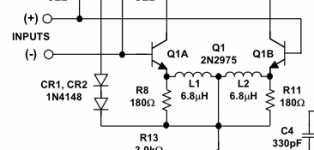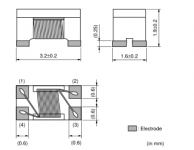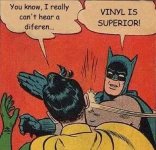Not if the circuit is designed to cope with it or designed to exploit it. Most audio circuits are not, so for them any grid current is a bad thing.nigel pearson said:Is grid current a bad thing ?
Nige, yes, I do use emitter degeneration, but (I feel) within reason. I read somewhere once a paper by an engineer from H/K's design department, which briefly stated that while degeneration of the input differential stage(s) is highly desirable, it must be kept in close check. This for two reasons:
1. The overall gain of the input stages must never go lower than 3:1, as the absolutely lowest permissible point. Go below and your sound dies on you. In my view, even that is a bit low for me, I typically do a gain of 5:1. This keeps it linear and keeps noise down, at the same time eliminating the need for any special compensation (althought in the end, it might still be needed), and
2. Degenerating the input differential(s) has a price one must pay. Reducing their gain increases the gain the VAS must deliver, and typically, this tends to seriously reduce the open loop bandwidth of the VAS and can sometimes force you to compensate by increasing VAS current to not so good levels. Exactly what that means depends on your overall circuit, but if you are using a three stage Locanthi type circuit (predriver, driver, output), your VAS is relatively offloaded anyway because of the tremednous DC gain of the three stage circuit, when even 6 mA of VAS current is quite enough. In such a case, you do have some current reserve, say off hand to about 10 mA for the VAS, but any higher and you start to need local heat sinks and very soon, you start needing special BJTs as well.
Therefore, it's a compromise you need to work out for good overall performance. Add to this the we don't really want too much current noise in the input stage, but need to balance this with what the input stage might need if driving very low loads at very large power levels, and it all need not a pint or two, but a barrel of cider to work out.
Personally, I like to drive my input differential(s) with bias currents of 1...1.5 mA per transistor, as all BJTs I use have managed almost peak performance by then. If using 2SK170, I usually go for 1.9 mA per FET; I still use it simply because it is one of the few audio FETs still in production, most others are gone, and I can find some hopefully near originals locally. It has proved its worth, so to speak, and its 40V limit is very handy.
However, getting the circuit to work electrically is one thing, while making it sound good is quite another. Not necessarily the same thing.
1. The overall gain of the input stages must never go lower than 3:1, as the absolutely lowest permissible point. Go below and your sound dies on you. In my view, even that is a bit low for me, I typically do a gain of 5:1. This keeps it linear and keeps noise down, at the same time eliminating the need for any special compensation (althought in the end, it might still be needed), and
2. Degenerating the input differential(s) has a price one must pay. Reducing their gain increases the gain the VAS must deliver, and typically, this tends to seriously reduce the open loop bandwidth of the VAS and can sometimes force you to compensate by increasing VAS current to not so good levels. Exactly what that means depends on your overall circuit, but if you are using a three stage Locanthi type circuit (predriver, driver, output), your VAS is relatively offloaded anyway because of the tremednous DC gain of the three stage circuit, when even 6 mA of VAS current is quite enough. In such a case, you do have some current reserve, say off hand to about 10 mA for the VAS, but any higher and you start to need local heat sinks and very soon, you start needing special BJTs as well.
Therefore, it's a compromise you need to work out for good overall performance. Add to this the we don't really want too much current noise in the input stage, but need to balance this with what the input stage might need if driving very low loads at very large power levels, and it all need not a pint or two, but a barrel of cider to work out.
Personally, I like to drive my input differential(s) with bias currents of 1...1.5 mA per transistor, as all BJTs I use have managed almost peak performance by then. If using 2SK170, I usually go for 1.9 mA per FET; I still use it simply because it is one of the few audio FETs still in production, most others are gone, and I can find some hopefully near originals locally. It has proved its worth, so to speak, and its 40V limit is very handy.
However, getting the circuit to work electrically is one thing, while making it sound good is quite another. Not necessarily the same thing.
Last edited:
Nige, yes, I do use emitter degeneration, but (I feel) within reason.
On this broad subject of LTP degeneration, has anyone experimented with inductors in parallel with the degen resistors? I first saw this in Deane Jensen's discrete opamp (did he patent it?) - more recently Samuel Groner has picked up the idea in his own discrete opamp design.
On this broad subject of LTP degeneration, has anyone experimented with inductors in parallel with the degen resistors? I first saw this in Deane Jensen's discrete opamp (did he patent it?) - more recently Samuel Groner has picked up the idea in his own discrete opamp design.
This dates to at least the 60's with Dick Burwen. Check out Walt Jung's op-amp history.
EDIT - Model AD121 1966
Last edited:
Cool - thanks Scott, that's very useful. Clip of the input stage attached.
<edit> Next question - those two inductors are obviously begging to become a common-mode choke. Any takers? Something like Murata DLW31 series, 1206. On relfection though, perhaps bifilar wound isn't the best choice.
<edit> Next question - those two inductors are obviously begging to become a common-mode choke. Any takers? Something like Murata DLW31 series, 1206. On relfection though, perhaps bifilar wound isn't the best choice.
Attachments
Last edited:
On this broad subject of LTP degeneration, has anyone experimented with inductors in parallel with the degen resistors? I first saw this in Deane Jensen's discrete opamp (did he patent it?) - more recently Samuel Groner has picked up the idea in his own discrete opamp design.
Beside the Jensen project, as far as I am aware, only Tandberg (remember them?) used it in their prestigious 3000 series. The 150W per side power amp has inductors in parallel with their input stage degen resistors.
H/K also used them extensively, although not in the input stage, but in the output stage, an inductor in parallel with the base resistors of the output stage.
If you are interested, give me an e-mail address and I'll send you Tandberg's Service Schematics manual. And a few H/K manuals to boot.
hvdc long range transmission gaining momentumIt is possible that non-linear resistive loss mechanisms do less damage at lower current demand, pure speculation. Certainly less power is lost by high voltage transmission lines.
edison would be proud
Originally Posted by scott wurcer View Post
It is possible that non-linear resistive loss mechanisms do less damage at lower current demand, pure speculation. Certainly less power is lost by high voltage transmission lines
Do tell what you think of a distributed PSU system.
That's the one which has a fully regulated say +/- 40V centrally. It is this power that is sent to individual circuit blocks in a say preamp, where it is the locally electronically regulated down to say +/-30V or +/-15V.
The theory is that in this manner, there is practically zero interaction between individually regulated blocks, both in terms of power requirements (if one pulls, others know nothing of it) and signal crosstalk. Also less problems with distribution around the case.
I am seriously considering this for a preamp based on my collection of AD op amps (OP37, AD829, AD818, AD828). They have been sitting around for far too long, it's time they earned their daily bread.
Well its official "Vinyl is dead "
BBC - Culture - Why have vinyl records become so popular in Germany?

BBC - Culture - Why have vinyl records become so popular in Germany?

As the text says, it's more about winning back some time.
LPs are definitely a masochistic hobby. You have to clean the LP, the stylus tip, you have to know how many LPs you have already played so you buy a good new stylus in good time, you have to adjust your turntable for weight, skating and make t level, and so forth.
And LPs actually wear out, no matter how expensive they may have been.
In return, you MAY be listening to a sound which is actually better than your typical CD. But it's the ritual of playing them that's important here. Those of us who never sold our turntables and LP collections know this well.
My guess is that vinyl may well make a serious come-back, but only in the middle and high price range. Sure, there are cheap TTs with USB links to the PC and phono RIAA EQs inside, but have you listened to their sound? Mostly in the "YUK!" category.
But it's nice to know I was right when I refused to sell of my Dual CS604 turntable. Or sell off my LP collection, about 600 LPs strong.
LPs are definitely a masochistic hobby. You have to clean the LP, the stylus tip, you have to know how many LPs you have already played so you buy a good new stylus in good time, you have to adjust your turntable for weight, skating and make t level, and so forth.
And LPs actually wear out, no matter how expensive they may have been.
In return, you MAY be listening to a sound which is actually better than your typical CD. But it's the ritual of playing them that's important here. Those of us who never sold our turntables and LP collections know this well.
My guess is that vinyl may well make a serious come-back, but only in the middle and high price range. Sure, there are cheap TTs with USB links to the PC and phono RIAA EQs inside, but have you listened to their sound? Mostly in the "YUK!" category.
But it's nice to know I was right when I refused to sell of my Dual CS604 turntable. Or sell off my LP collection, about 600 LPs strong.
LP sound these days seems to be a lucky dip - I was surprised at the recent Sydney audio with the generally poor sound from vinyl, only one TT out of more than a dozen I heard in operation had any real life to it; a friend's low cost but highly tuned rig easily beat all except that one high cost unit ...
I reckon you're only right because you've yet to fully mod up your TDA1543 Lite DACI don't miss my LPs, sold off many years ago.
Get over it , the little digits haven't surpassed LP sound regardless how many times you mod your little Ebay chip set ...
Do tell what you think of a distributed PSU system.
That's the one which has a fully regulated say +/- 40V centrally. It is this power that is sent to individual circuit blocks in a say preamp, where it is the locally electronically regulated down to say +/-30V or +/-15V.
The theory is that in this manner, there is practically zero interaction between individually regulated blocks, both in terms of power requirements (if one pulls, others know nothing of it) and signal crosstalk. Also less problems with distribution around the case.
I am seriously considering this for a preamp based on my collection of AD op amps (OP37, AD829, AD818, AD828). They have been sitting around for far too long, it's time they earned their daily bread.
The problem with schemes like this is the grounding scheme. At some point, all the return currents have to come back to the master source. Even when you use a star ground for all the local supply returns back to the master, if all stages have the same ground reference for the signal, I don't know a way to keep the ground ripple out of the signal of the various blocks, unless you go fully balanced. If you go balanced, each signal brings its own reference and ground is no longer an issue (or at least much, much less).
For unbalanced systems, the only possible way it to have local regs that are galvanically isolated from the master supply which implies some form of optically isolated local sources.
Although, local shunt regs instead of series regs do come closer to the ideal because they can keep the return current ripples local to the stage and not back to the rest of the system.
jan
Get over it , the little digits haven't surpassed LP sound regardless how many times you mod your little Ebay chip set ...

Attachments
As the text says, it's more about winning back some time.
LPs are definitely a masochistic hobby. You have to clean the LP, the stylus tip, you have to know how many LPs you have already played so you buy a good new stylus in good time, you have to adjust your turntable for weight, skating and make t level, and so forth.
And LPs actually wear out, no matter how expensive they may have been.
In return, you MAY be listening to a sound which is actually better than your typical CD. But it's the ritual of playing them that's important here. Those of us who never sold our turntables and LP collections know this well.
My guess is that vinyl may well make a serious come-back, but only in the middle and high price range. Sure, there are cheap TTs with USB links to the PC and phono RIAA EQs inside, but have you listened to their sound? Mostly in the "YUK!" category.
But it's nice to know I was right when I refused to sell of my Dual CS604 turntable. Or sell off my LP collection, about 600 LPs strong.
Interesting , I have never worn out an LP or a stylus, i cant imagine what kind of VTF is needed and the many repeated playing to do so ...
How many times can you play one LP to wear it out ......

Interesting ,
I have that and more on a few of my cartridges without noticeable degradation of any kind, as a matter of fact it takes 30 hrs for the cartridge to break in, at around this time vtf/ vta has to be readjusted due to change in compliance , et al, this is also when the setup is at its sonic best ... A hundred hrs is achieved easily in 4-6 months , i know of no one replacing their stylus with such limited use....

I have that and more on a few of my cartridges without noticeable degradation of any kind, as a matter of fact it takes 30 hrs for the cartridge to break in, at around this time vtf/ vta has to be readjusted due to change in compliance , et al, this is also when the setup is at its sonic best ... A hundred hrs is achieved easily in 4-6 months , i know of no one replacing their stylus with such limited use....

Last edited:
- Status
- Not open for further replies.
- Home
- Member Areas
- The Lounge
- Sound Quality Vs. Measurements


